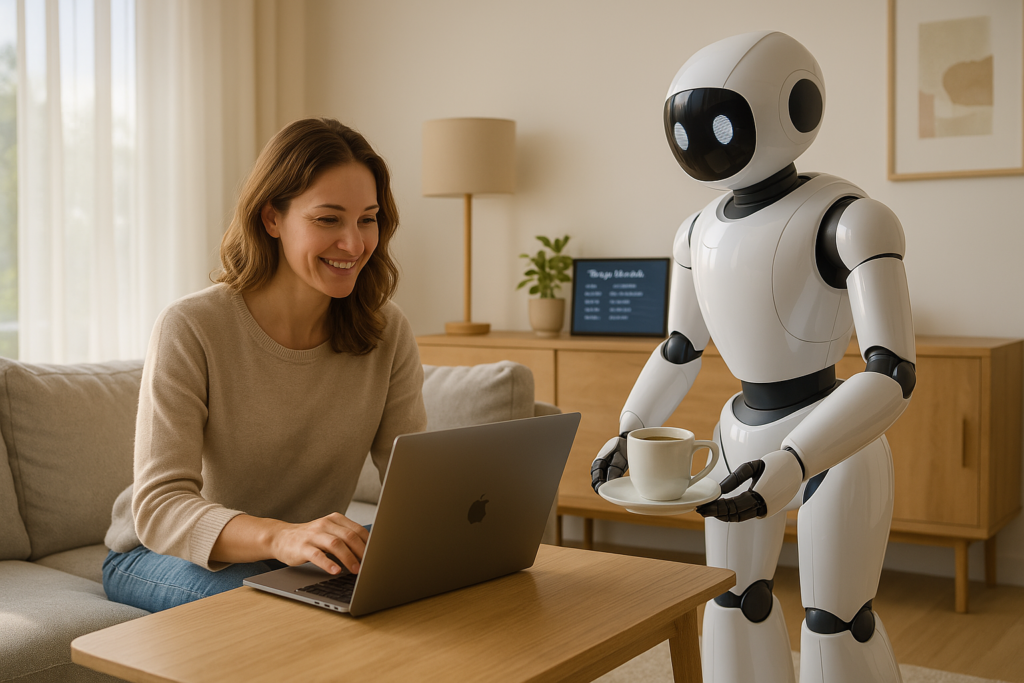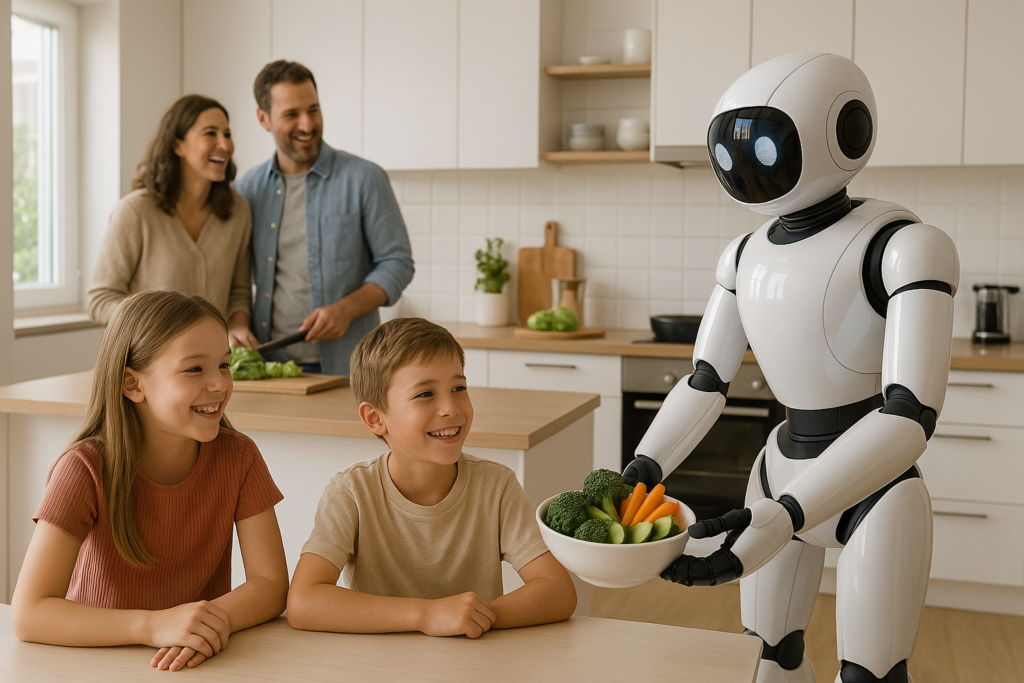
The dream of having a personal robot assistant at home, a helpful companion like Rosie from “The Jetsons,” has captivated imaginations for decades. While we’re still some way from fully autonomous humanoid butlers – though progress on humanoid robots is advancing rapidly – rapid advancements in artificial intelligence (AI) and robotics have brought a fascinating generation of smart home robots to the market. These aren’t just simple automatons; many of the AI home robots available now can navigate complex environments, learn from interactions, and perform useful tasks with surprising autonomy.
This article explores the world of AI home robots available now – real products you can purchase and integrate into your daily life today, moving beyond futuristic concepts. We’ll examine the main categories, delve into their AI-powered functionalities, compare options, and assess the real benefits (and limitations) they bring to the modern household.
The Dominant Force: Smart Cleaning Robots (Vacuums & Mops)
This is, by far, the most mature and popular segment of the AI home robot market. Early robot vacuums were relatively basic, relying on random bump-and-go algorithms. Today’s top models are sophisticated cleaning machines.
What Makes Them “AI-Powered”?
- Intelligent Navigation (SLAM/vSLAM/LiDAR): Premium robots employ advanced sensors (cameras, LiDAR lasers) to create precise maps of your home (Simultaneous Localization and Mapping – SLAM). AI algorithms interpret this data to plan efficient cleaning routes, avoid getting stuck, and ensure comprehensive coverage, even in complex layouts. They learn the most effective paths over time.
- Object Recognition & Avoidance (Computer Vision): This is where AI truly shines in cleaning bots. Advanced models use cameras and AI processing to identify and steer clear of specific objects on the floor – cables, shoes, socks, toys, and crucially, pet waste. These AI home robots available now are trained on vast datasets to recognize potential hazards, preventing tangles or messy disasters.
- Smart Mapping & Customization: Associated mobile apps display the robot-generated maps. Users can define virtual boundaries (no-go zones), specify areas where mopping should be avoided (on rugs), or direct the robot to clean a specific room or spot (e.g., “clean under the kitchen table”). The AI learns and optimizes these maps with use.
- Adaptive Suction Power: Some robots automatically detect the surface type (hard floor vs. carpet) and adjust suction power accordingly. This maximizes cleaning effectiveness and conserves battery life.
- Advanced Self-Maintenance Stations: The latest trend involves sophisticated docking stations. These not only charge the robot but also automatically empty its dustbin. For combined vacuum-mop units, top-tier stations can also wash and even dry the mopping pads, drastically reducing the need for human intervention.
Leading Brands & Examples:
Brands like iRobot (Roomba), Roborock, Ecovacs (Deebot), and Dreame dominate this space, constantly pushing the boundaries of what these AI home robots available now can achieve. Models like the Roborock S8 Pro Ultra or Ecovacs Deebot T20 Omni showcase the peak of current cleaning automation.
Beyond Cleaning: Other Useful AI Home Robots Available Now
While cleaning bots lead the charge, other categories of AI home robots available now are emerging, offering different forms of assistance and interaction.
Home Security & Monitoring Robots
These mobile sentinels add an autonomous layer to home security. Instead of static cameras, they can patrol predefined routes or investigate detected disturbances.
- AI Features: Person detection (distinguishing humans from pets or shadows), sound detection (listening for alarms or breaking glass), facial recognition (on some models, to recognize family members), and autonomous patrolling based on schedules or sensor triggers.
- Examples: While the flying Ring Always Home Cam remains somewhat niche, ground-based robots like the Enabot EBO AIR or SE offer mobile monitoring with AI features like pet/human tracking and automatic patrolling/docking. They act as movable eyes and ears for your home.
AI Companion & Social Robots
Designed for interaction and companionship, these robots aim to combat loneliness, assist with daily tasks, or provide engaging interaction, often targeting seniors or families.
- AI Features: Natural language processing (understanding and responding to voice commands), learning user preferences and routines, proactive engagement (initiating conversations or reminders), facial recognition, and emotional expression simulation.
- Examples: ElliQ is a prominent example designed specifically for older adults, aiming to encourage activity and connection through conversation, reminders, and facilitating communication. Miko 3 is geared towards kids but functions as a family companion, offering games, educational content, and interactive conversation powered by AI. These AI home robots available now focus on relationship building rather than physical tasks.
Educational AI Robots for Kids
These robots leverage AI to make learning more interactive and engaging for children, often focusing on STEM concepts.
- AI Features: Adaptive learning (adjusting content based on the child’s progress), conversational interaction for Q&A and storytelling, coding interfaces (teaching programming concepts), and computer vision for interactive games.
- Examples: Miko 3 (mentioned above) fits strongly in this category. Roybi Robot is another example specifically focused on language learning and early STEM education, using AI to personalize lessons.
Specialized Outdoor Robots (Lawn & Pool)
AI is also making its way outdoors, automating tedious yard work.
- AI Features: Smart navigation around complex lawns (using GPS, cameras, or boundary wires), object avoidance (trees, garden furniture), adaptive mowing patterns for efficiency, and automated scheduling. Pool cleaning robots use AI for mapping pool shapes and optimizing cleaning paths.
- Examples: High-end robotic lawnmowers from brands like Husqvarna (Automower series) incorporate AI for pathfinding and object recognition. AI-powered robotic pool cleaners from companies like Dolphin efficiently navigate and scrub pool surfaces.
Comparing the Options: Features, Prices & Suitability of AI Home Robots Available Now
Choosing the right robot depends heavily on your needs and budget. Here’s a comparative look at the main categories of AI home robots available now:
| Robot Type | Example Models | Key AI Features | Price Range (USD Est.) | Ideal For | Buy Button (Concept) |
| Cleaning (Vac/Mop) | Roborock S8 Pro Ultra, Ecovacs Deebot T20 Omni, iRobot Roomba Combo j9+ | LiDAR/vSLAM Navigation, AI Obstacle Avoidance, Smart Mapping, Auto-Empty/Wash | $800 – $1600+ | Busy homeowners, pet owners, tech enthusiasts | [Buy Now] |
| Home Security | Enabot EBO AIR / SE | Autonomous Patrol, Person/Pet Detection, Sound Detection, Remote Viewing | $100 – $250 | Home monitoring, pet watching, basic security | [Buy Now] |
| AI Companion | ElliQ (Subscription based), Miko 3 | NLP, Proactive Engagement, Learning User Preferences, Facial Recognition | $250 – $600 + Subs | Seniors living alone, families seeking interaction | [Buy Now] |
| Educational (Kids) | Miko 3, Roybi Robot | Adaptive Learning, Conversational AI, Coding Interface, Interactive Games | $200 – $400 | Parents wanting engaging STEM/language tools | [Buy Now] |
| Robotic Lawn Mower | Husqvarna Automower 430X NERA | Smart Navigation (GPS/Wire), AI Object Avoidance, Zone Control, Auto-Scheduling | $1500 – $5000+ | Homeowners with medium to large lawns | [Buy Now] |
| Robotic Pool Cleaner | Dolphin Nautilus CC Plus / Premier | Pool Mapping/Scanning, Optimized Cleaning Paths, Wall Climbing | $700 – $1500+ | Pool owners seeking automated cleaning | [Buy Now] |
Note: Prices are approximate estimates and can vary significantly based on sales, specific models, and regions. Subscription costs may apply for some companion robots.
(Website Implementation Note: Replace [Buy Now Link] with actual affiliate or direct purchase links where applicable, potentially using visually appealing buttons).
The Reality Check: Benefits vs. Limitations of Current AI Home Robots
While the progress is exciting, it’s important to have realistic expectations about the AI home robots available now.
Benefits:
- Convenience & Time-Saving: Automating chores like vacuuming, mopping, or lawn mowing frees up significant time.
- Improved Accessibility: Companion robots can assist seniors with reminders and communication; security bots offer remote presence.
- Enhanced Cleaning/Monitoring: AI navigation and object recognition often lead to more thorough cleaning or smarter surveillance than simpler devices.
- Engagement & Education: Companion and educational robots offer novel ways to interact and learn.
- Remote Control & Monitoring: Most smart robots can be controlled and monitored via smartphone apps from anywhere.
Limitations:
- Cost: Advanced AI robots, especially high-end cleaning and lawn models, represent a significant investment.
- Imperfect AI: Navigation can still fail occasionally (getting stuck), object recognition isn’t foolproof (misidentifying items), and natural language understanding in companion bots has limits.
- Maintenance: Robots require regular maintenance – cleaning brushes, emptying bins (if no auto-empty), replacing filters, managing boundary wires (for some mowers), software updates.
- Privacy Concerns: Robots equipped with cameras and microphones roaming your home raise valid privacy questions. Choosing reputable brands with clear privacy policies is crucial. Organizations like the Electronic Frontier Foundation (EFF) often discuss the privacy implications of smart home devices.
- Limited Dexterity & Functionality: Most current home robots are highly specialized. They can’t perform general-purpose tasks requiring manipulation (like tidying up clutter, cooking, or doing laundry).
The Future Outlook: What’s Next for Home AI Robots?
The field is evolving rapidly. We can expect future AI home robots available soon to feature:
- More Advanced AI: Improved reasoning, better contextual understanding, and more natural interaction.
- Enhanced Dexterity: Robots with more capable arms and grippers for performing a wider range of tasks (though this is still a major challenge).
- Better Human-Robot Collaboration: Robots designed to work more seamlessly alongside humans, perhaps even moving towards more direct control methods explored in fields like Brain-Computer Interfaces.
- Tighter Smart Home Integration: Deeper integration with other smart home devices and ecosystems (like Google Home, Amazon Alexa, Apple HomeKit).
- More Affordable Options: As technology matures and scales, costs for sophisticated features may decrease.

Conclusion: Bringing AI Home – Intelligently
The era of the home robot is no longer pure science fiction. A growing number of useful AI home robots available now can genuinely make life easier, safer, or more engaging. From diligent cleaning bots meticulously navigating your floors to companion robots offering conversation, the practical applications of domestic AI are expanding.
However, it’s essential to approach purchasing with clear eyes. Understand the specific tasks a robot is designed for, research its AI capabilities (and limitations), consider the maintenance involved, and weigh the cost against the convenience offered. Privacy implications should also be carefully considered.
While we await the arrival of truly general-purpose robotic assistants, the specialized AI home robots available now represent significant milestones. They offer a compelling glimpse into a future where intelligent machines become increasingly integrated into our homes, automating the mundane and augmenting our lives in meaningful ways. Choosing wisely today means welcoming a capable, if specialized, AI helper into your home.




Quick observation… “Front” might be misspelled. spellingreport.com or something similar usually helps verify quickly.
Thanks,
Samuel